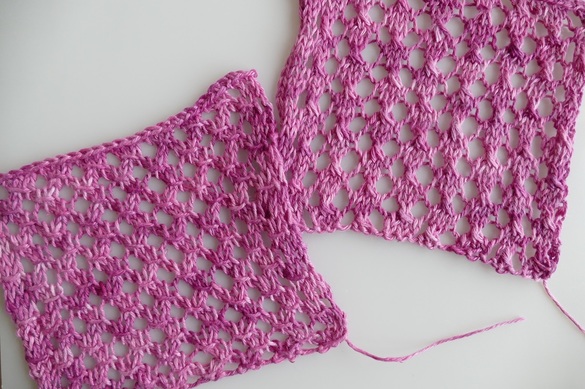Knitting with 100% linen yarn. Useful tips.
 Lace swatches in 4-ply linen
Lace swatches in 4-ply linen
Knit a sample to test your gauge.
If you are making a garment where size is critical, it is important to knit a swatch beforehand to check the gauge matches that of the pattern you are following. You should wash and dry all samples before measuring your gauge. The knitted fabric relaxes after the first time it has been washed and the gauge will change. Your piece will probably become slightly longer in length, and slightly smaller in width. If you are knitting with linen for the first time, this will also help you get a feel for it.
Handy tip: I have actually kept many of my samples and use them as small face cloths. Linen is anti-bacterial and naturally exfoliates, so it is quite suited to this purpose.
Knitting with linen will often produce a light and airy stitch, with an almost sheer effect. This is because the fibres, which are strong and smooth, do not puff out like wool to fill the spaces in between the stitches. If you wish to increase this effect, you can knit with slightly larger needles. Personally, I prefer the more compact stitch, so I usually end up going down to smaller needles (3.5mm).
I am quite a neat knitter and have found that my stitches look more irregular with linen, but as soon as the piece is washed, the stitches miraculously even out.
Preparing your skein for knitting/crochet.
Your hand-dyed linen will probably arrive in a skein. You will need to wind this into a ball. I don't really recommend using a ball winder, because these tend to add more twist to the yarn if the skein is not placed flat on the umbrella swift. Our linen is spun with very low twist, in order to avoid biasing when it is knit up. If you add twist by mechanically winding into a ball, you may increase the chances of your yarn biasing. I prefer to wind my linen the old-fashioned way, by hand. This usually involves asking someone else to hold the skein for me around their hands, or, if you have a swift, you can pop it round the swift, making sure the skein lies flat and is not twisted, and wind it off by hand. Don't attempt any other method or you could get into a nasty tangle!
If you do decide to wind the yarn into a cake, don't pull the yarn from the centre of the cake. Knit the yarn coming from the outside of the cake. Knitting from the centre is a lot more likely to add twist to your yarn and cause your piece to bias.
Start with a small project.
If you are using linen for the first time, it's a good idea to start with something small, like a cowl/scarf or a wash-cloth. This will help you get the feel of the yarn before embarking on a more ambitious project with shaping. If you are used to the buttery softness and the squishy feel of wool, linen will not feel the same as you work with it. There is no natural elasticity in the fibres so when you knit/crochet the yarn will not give as much as with wool, and the yarn can feel quite crisp. I was apprehensive about this the first time I tried linen, but after a few rows, I found myself speeding along as usual. It was quite similar to knitting with cotton yarn. Strands of linen are very strong and quite unruly, but even though the yarn feels quite stiff on the skein, it starts to soften as you wind it into a ball and as you handle it more and more and work with it.
We only have a small range of patterns on our website (we are working on this....!) but we have gathered many ideas for small and larger projects on our Pinterest linen page.
Just click on widget below to browse. Some link to free patterns.